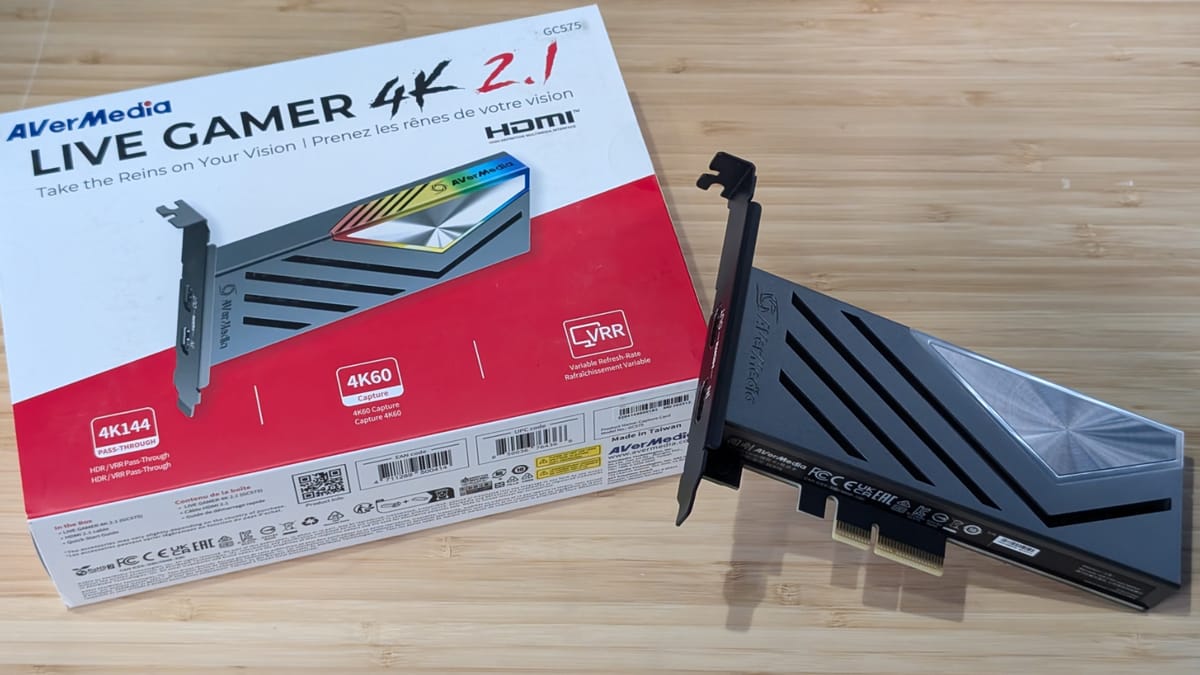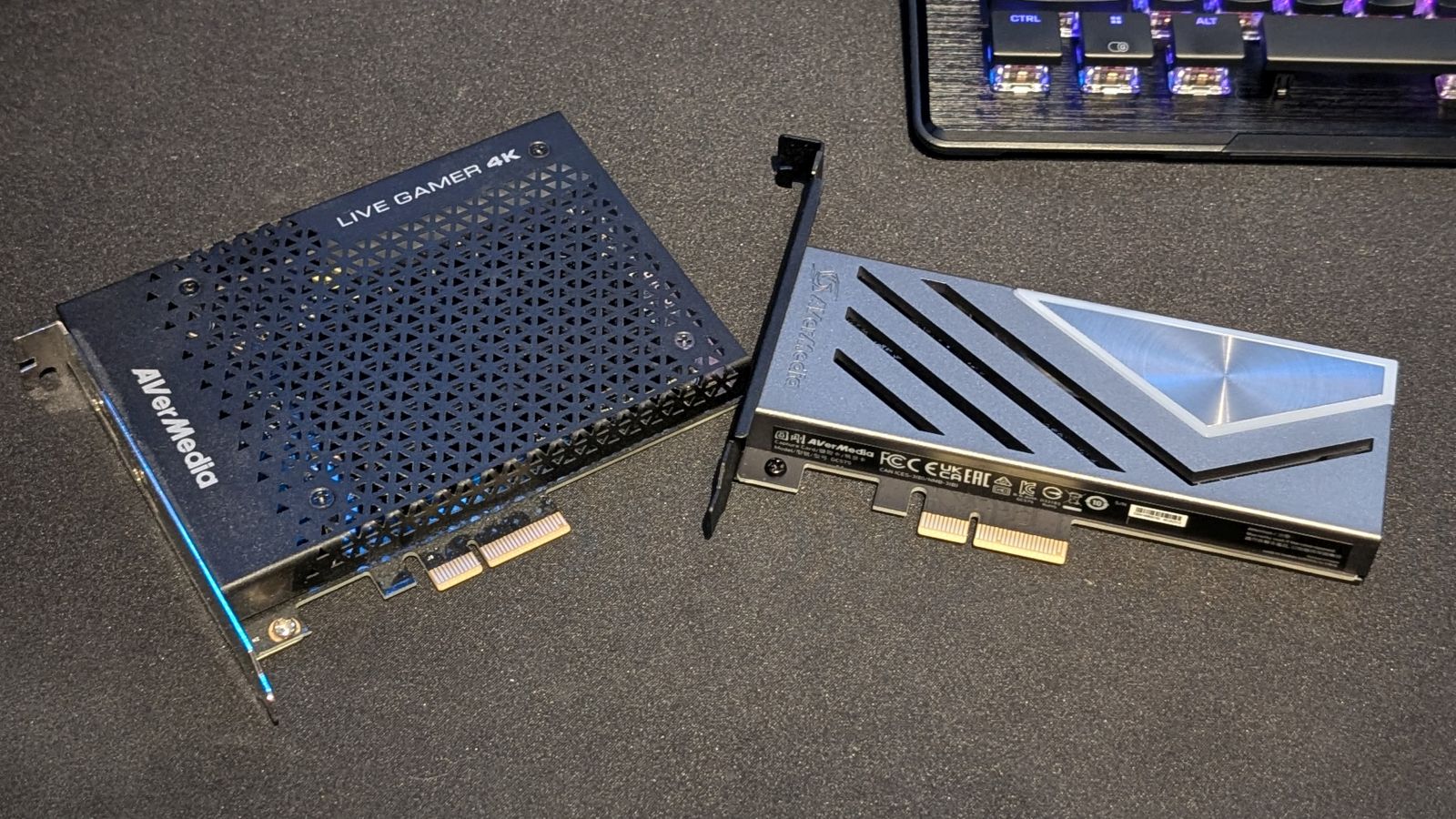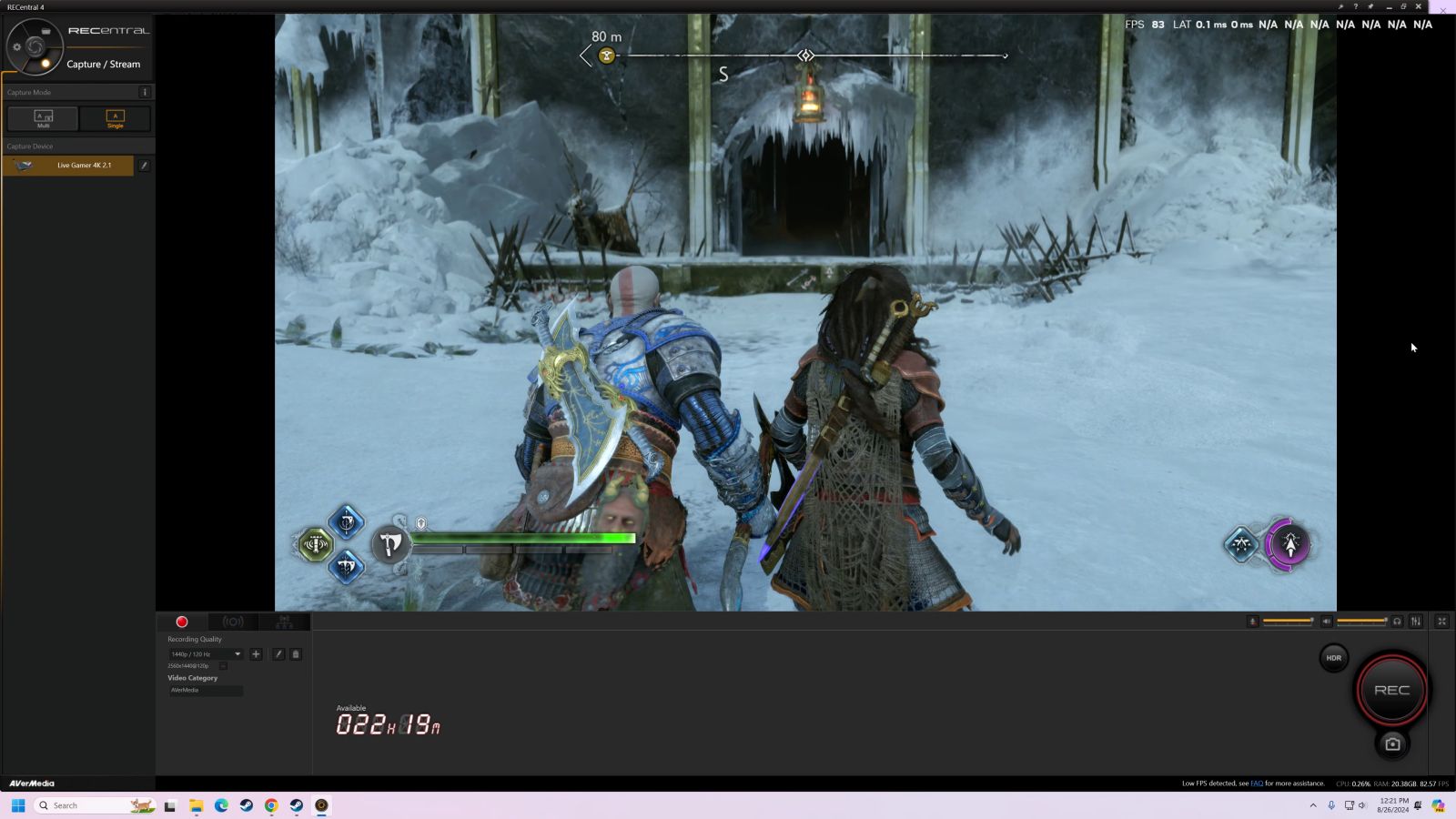
When it comes to capture and streaming, we want things to be quick and easy. Not too long ago it took an octopus of cables to your TV or receiver, another octopus of cables to the console, and a whole lot of configuration and hoping that the results would be usable. What if I told you that it could be done with a single cable nowadays? What if I also told you that you could now capture at 4K/60 while still enjoying the full refresh rate of your console without the need to set the source at just 60fps? Well, that’s precisely what the AVerMedia Live Gamer 2.1 4K PCIe capture card aims to do.
If the AVerMedia Live Gamer 4K 2.1 sounds familiar, it’s because that “2.1” part is new, but the rest we’ve seen before. This is an update to a card that the team released in 2018 that also recorded in 4K/60. So what does this new card bring to the table that the previous one didn’t? Well, quite a bit, actually. First and foremost, it supports HDR (High Dynamic Range lighting) and VRR (Variable Refresh Rate). Second, the fastest pass-through resolution and refresh rate combination was 2160p60, better known as “4K/60”. That means you’d have to set the game console to 4K/60, and then limit the capture to 4K/60, and the output to 4K/60. When games can now handle 120Hz or 144Hz, you’ll want your card to do the same, right? Well, that simply wasn’t possible, until now.

If you’ve captured video on the PlayStation 5 or Xbox Series X|S then you’ve found the limitations. .webm is a terrible format for editing, the .mp4 option is limited to an hour, compressed, framerate limited, and worst of all, may suddenly cut out with a “This scene cannot be captured” without warning. Both consoles are also limited to an hour, regardless of how much storage space you’ve got. Streaming directly has just as many limitations – didn’t I just say this is easier nowadays? Well, that’s where an external capture device comes in.
You should know that, with the right games, the PlayStation 5 is capable of 4K resolution, 120Hz refresh rate, variable refresh rate (VRR), and high dynamic range lighting (HDR). The Xbox Series X bumps up a little bit higher, hitting a refresh rate of 144Hz. It’s also very likely that the upcoming pro version of the PlayStation 5 will be easily able to hit those numbers (and possibly 144Hz if rumors prove to be true), provided you’ve got the rest of the parts in that chain. You see, it’s right there in the device name – AVerMedia Live Gamer 4K 2.1. In this case, the 2.1 stands for HDMI 2.1, so let’s dig into that once we’ve got it installed.

Installation of the Live Gamer 4K 2.1 requires an open PCIe Gen 3×4 slot. The good news is that’s probably your lowest spot on your motherboard, and the least likely that it’s in use. Even on the oldest of motherboards, it’s also going to clear the bar on the Gen 3×4 requirements. From there you simply press it in and secure it like you would any other card – there are no cables, power wires, or anything else required. Bringing it up, surprisingly, no driver is required. That’s to say, if you don’t want to use AVerMedia’s software, you don’t have to – just fire up OBS and it’ll recognize it and make use of its full capabilities. That said, don’t skip out on RECentral 4 – it’s come a long way. Now that it’s installed and powered up, let’s talk about cabling.
HDMI 2.1 is a fairly recent advancement in the HDMI standard. Just like USB, the powers that be have made the naming convention needlessly complicated. HDMI 2.0 gave us 4K resolution at 60fps over the wire. HDMI 2.0b provided the same frame rate and resolution, or 120 Hz and 144 Hz refresh rates, but at 1080p. It wasn’t until we got HDMI 2.1 that we finally achieved 4K resolution at 144 Hz, or 8K at 60 Hz, and even 10K resolution at 30 Hz. It’s important to know, however, that everything in your chain has to be compatible. This means if you are using a TV and receiver as well as a console, your display, the receiver, the cables, and the console will all need to be able to hit whatever console and resolution you want. Inside the box for the Live Gamer 4K 2.1 is a short 4K/144Hz capable cable (which is labeled, thank you very much), but depending on where you place your console, it might not be long enough. I personally like these JSAUX cables as they are inexpensive, hit all the specs, and are from a company we know and trust.

By way of comparison, the 4K 2.1 is roughly half the size of its predecessor. While this isn’t a surprise with the way technology moves, it wasn’t an ask – the previous one wasn’t that big to begin with, but AVerMedia has made it more sleek and stylish. On the outside edge is a full RGB white plastic section emblazoned with “AVerMedia”. Using the included software it has baked in support for Windows Dynamic Lighting (at least on Windows 11), ASRock Polychrome Sync, MSI Mystic Light Sync, and Gigabyte RGB Fusion 2.0. Yes, it’ll jump and dance to whatever game you’re playing, or you can turn it off if you wish, but it has other uses beyond that. If you’ve got a failure in the chain of some sort (cable not fully seated for example) it’ll be solid red to let you know it’s not quite ready for capture (no device detected), flashing blue (updating firmware), a rainbow (ready to go!), and a handful of others. Or you can turn it off entirely if you’re the grumpy type.
With the card installed and powered up, the next step is to fire up the AVerMedia Assist Central app. This tool will happily and easily update the firmware with a single click. I don’t normally talk up the side software for most gear as it can be pretty bloatware-adjacent, but both RECentral 4 and Assist Central are very lightweight and do not run in the background when not in use.

I personally prefer this PCIe card over the AVerMedia Live Gamer Ultra 2.1. It’s not for any differences in capabilities – they’ll both deliver everything we’ll talk about in this review – no, it’s for the simplicity. With a single cable I can connect any console I have, from my NES Mini to my PlayStation 5 or Xbox Series X, and capture from it instantly. Why? This single card supports every resolution for capture from 480p to 4K. Better still, it’s great for eSports as it can capture a blisteringly fast 1080p at 360 Hz, 1440p at 120 Hz, and 2160p at 60 Hz. It can even handle ultra-wide (3440x1440p) at 100 Hz, which I believe is unique to this device. Now, all of this isn’t new – much of this capability was possible on this card’s predecessor, as we talked about in my review for it back in 2018. What’s different, and what makes this card potentially worth an upgrade, and certainly the go-to choice if you are starting new, is the passthrough capabilities.
With any other capture unit out there, you have to set your source’s resolution and refresh rate to the highest possible level, but that’s also the level you’re then forced to play. That means, if you want to play a game like Devil May Cry 5: Special Edition using its 120 Hz mode (it tends to hover around 100 Hz), you can’t – you’re stuck at 60, because that’s the capture rate. With the Live Gamer 4K 2.1, that’s no longer the case. With this card you can capture at 4K/60 while playing at up to 144Hz and 4K resolution. It’s not a short list of games that support 120Hz at full rate, either. A Plague Tale Requiem, Atomic Heart, Bright Memory Infinite, Deathloop, F1 22 and F1 23, Ghostwire Tokyo, Gran Turismo 7, Hogwarts Legacy, Horizon Forbidden West, WRC 9 and 10, XDefiant, and more support 120 Hz at full 4K. A far larger list will take advantage of VRR to adjust both framerate and resolution to simply push the game to run as fast as it can while looking as good as possible on PlayStation 5. The Xbox Series X has the Battlefield series, Apex Legends, Destiny 2, ExoMecha, Gears 5, Halo: The Master Chief Collection, JYDGE, pretty much all of the LEGO series, Mad Max, the Metro series, Minecraft Dungeons, Persona 3 and 4, the Resident Evil remakes (2 and 3), as well as RE7: Biohazard, Star Wars: Squadrons, both Titanfall games, and many more support 4K, with a far larger list doing exactly what I described with variable refresh rates and resolutions. It’s awesome to be able to record at full resolution and speed, but with the ability to play it lag-free, and at refresh rates in games where every frame counts to make those split-second timings. When frames make games, the last thing you want is your capture card to let you down, and thankfully that won’t happen here.
Now that we’ve got a lesson in HDMI specs, it’s fair to say that capture systems have been lagging behind consoles for a while. The PlayStation 5 and Xbox Series X|S launched four years ago, but got 120Hz support in April of 2021. Until capture units embraced HDMI 2.1, however, 4K/60 was the best you can do. Now, that’s no slouch, as you’ll see in the capture below, but being able to capture it as the developer intended is a whole different story. Let’s look at what this card is capable of delivering at 4K/60 with a peek at Stellar Blade on PS5 in Performance Mode. Before we do, I’m double-capturing, showing the game in motion, while also showing the process of capturing it – essentially capturing the capture of the capture. I sincerely doubt that it’ll affect anything as my PC has more than enough horsepower to process the capture but what you’re seeing is AVerMedia’s RECentral 4 running to capture the output from the PS5, with NVIDIA’s FrameView displaying framerate in the corner, and the output of all of that being captured by NVIDIA’s capture app. Let’s start with Stellar Blade as it requires some pinpoint timing to do a perfect parry of the critters you encounter. I’ll be using the Performance Mode which allows the game to run at 60fps at 1440p.
Let’s bump this up a notch. There are some games that really benefit from hitting that 1440p/120 sweet spot, such as God of War: Ragnarök. Realize that YouTube can’t display 1440p/120, so hopefully the smoothness of the combat conveys it. I’m a bit rusty, so forgive my skill gap.
The last thing we always cover in hardware reviews is warranty and price. Since this is a multi-generational upgrade, we’ve got some data on failure rates of previous capture units. I’ve been using one in my PC for years at this point, and another staff member has a card installed as well. So far, over the course of half a decade or more, that failure rate is zero. AVerMedia offers up a 3 year warranty for peace of mind that it’ll serve your purpose for years to come. Better still, AVerMedia uses a unified software package for all of their devices, so you can expect software support for quite a while into the future. In fact, I don’t think I’ve seen a device fall off the list to date. At the time of writing, the card is on sale for just $219, and frankly that’s a steal for what this card can do right out of the box. There are certainly cheaper options out there, but none that have the passthrough capabilities of the Live Gamer Ultra 2.1, or the driverless ease of use. It can handle all of the current-gen consoles, and will very likely work well on whatever comes next. If you are serious about streaming or capture, this is the way.
Ultimately, the AVerMedia Live Gamer 4K 2.1 is an excellent upgrade, even over its predecessor. It takes everything that worked with the previous generation, embraces the needs of the newest consoles, and is ready for whatever comes next. It simply doesn’t get easier than this.
AVerMedia Live Gamer 4K 2.1 PCIe Capture Card
Phenominal
The AVerMedia Live Gamer 4K 2.1 PCIe capture card is the easiest non-proprietary way to capture whatever device you can imagine, from retro to current, showcasing the very best visuals, at whatever framerate it can dish out. There is simply nothing better on the market.
Pros
- Unrivaled passthrough capabilities
- Single cable connection, zero drivers
- Supports OBS or RECentral 4
- 3 year warranty and extensive software support
- Excellent for eSports capture
- PCIe capture makes storage a cinch
Cons
- Included cables are short
